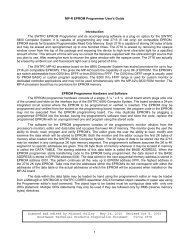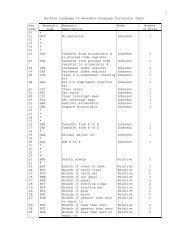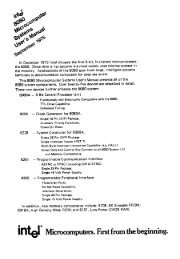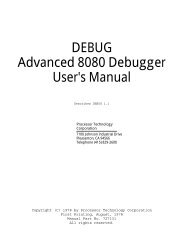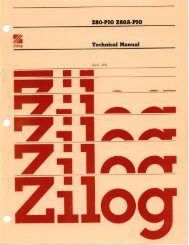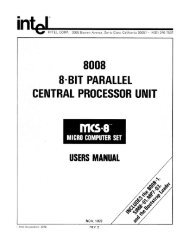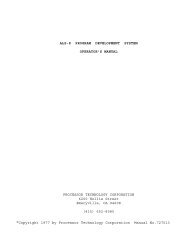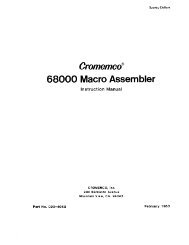The System Manual of SOL-20 - History of Computers
The System Manual of SOL-20 - History of Computers
The System Manual of SOL-20 - History of Computers
Create successful ePaper yourself
Turn your PDF publications into a flip-book with our unique Google optimized e-Paper software.
PROCESSOR TECHNOLOGY CORPORATION<br />
Sol THEORY OF OPERATION<br />
SECTION VIII<br />
Normally the internal display address is multiplexed to the<br />
Display RAM. When the CPU or a DMA device requests access (!PAGE_CC<br />
active), the multiplexers switch to the external address lines,<br />
ADR0-9.<br />
Seven-bit ASCII-coded data is written into RAM chips U14<br />
through U<strong>20</strong> from bits DIO0-6 <strong>of</strong> the Bidirectional Data Bus, and the<br />
cursor bit (DIO7) is written into RAM chip U21. This writing occurs<br />
when the write enable (WE) input to the RAM chips is low. This occurs<br />
when the Display RAM is addressed (!PAGE_CC active low) and<br />
MWRITE on S-100 Bus pin 68 is high. <strong>The</strong> enable is supplied on output<br />
pin 8 <strong>of</strong> NAND gate U44. Data is read out <strong>of</strong> the Display RAM<br />
when pin 8 <strong>of</strong> U44 is high. Data out <strong>of</strong> the Display RAM is placed on<br />
the Bidirectional Data Bus via tri-state drivers U29 and U89 when<br />
!PAGE_CC and PDBIN (S-100 Bus pin 78) are active. U29 and U89 are<br />
enabled by a low output on pin 11 <strong>of</strong> another U44 NAND gate.<br />
Data out <strong>of</strong> the Display RAM is also strobed into Data<br />
Latches U26 and U27 by LOAD_CLOCK. Seven outputs from these latches<br />
are used to address the Character Generator ROM, U25. Note that the<br />
output from RAM chip U19 is inverted in exclusive OR gate U74 before<br />
being applied to the C input (pin 13) <strong>of</strong> U26, and the complement<br />
(pin 14) <strong>of</strong> the QC output <strong>of</strong> U26 is used in addressing U25. This is<br />
done so that the Data latches will output the space code (0100000)<br />
to the Character Generator ROM when the latches are reset. <strong>The</strong>se<br />
latches are reset each time !PAGE_CC is active by way <strong>of</strong> U75, a J-!K<br />
flip-flop connected as a D flip-flop, and D flip-flop U42 (Q output<br />
pin 6). By outputting the space code on reset, the Data Latches<br />
insure a blank character position on the screen.<br />
<strong>The</strong> Character Generator ROM, U25, has seven character address<br />
inputs (A1 through A7), four scan line inputs (RS1 through<br />
RS4) and seven data outputs (B1 through B7). It is programmed to<br />
generate seven bits (dots) <strong>of</strong> character information for the selected<br />
scan line <strong>of</strong> the character row. U25 also automatically blanks scan<br />
lines that are not a part <strong>of</strong> the character and shifts the g, j, p,<br />
q, y, comma and semicolon to the fifth through 13th scan lines in<br />
the dot matrix (refer to Figures 8-2 and 8-3 on Page VIII-24). Complete<br />
patterns for the 6574 and 6575 Character Generator ROM's are<br />
provided in Figures 8-5 and 8-6 respectively. Note that the address<br />
bits A0 through A6 in Figures 8-4 and 8-5 correspond to the A1<br />
through A7 inputs to U25 on the schematic, scan lines R0 through R8<br />
are specified by the RS1 through RS4 inputs to U25 on the schematic,<br />
and the data output bits D0 through D6 correspond to the B1 through<br />
B7 outputs from U25 on the schematic.<br />
Let's see how the Character Generator ROM produces a character<br />
using an uppercase "C" and "T" as an example. In this example,<br />
these two characters are to be displayed in the first and second<br />
character positions respectively on the third character row <strong>of</strong> the<br />
display screen. Remember that the character position and row parameters<br />
are contained in the Display RAM since the 7-bit ASCII-coded<br />
VIII-29



